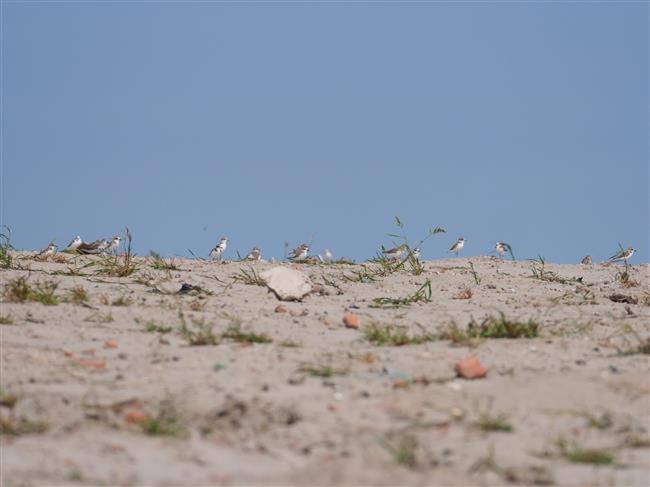Wild Shanghai EP4: Nanhui Dongtan welcomes migrating birds
Shot by Hu Jun. Edited by Hu Jun.
Nanhui Dongtan, located in the east most corner of Shanghai, is definitely the No.1 birding site in Shanghai.
The inter-tidal mudflats, shallow water ponds and 'magic forests' attract thousands of migratory birds passing by and wintering here. It also attracts many birders. Many rare bird species have been recorded here. Come to see the birds in the second World Migratory Bird Day of 2022.
紫寿带 Japanese Paradise Flycatcher
They are very pretty passage birds. They have a black head with crest, brown to purple back and tail and black breast. The breeding male birds have very long tails and big eyes with a blue circle around them.

A male Japanese Paradise Flycatcher in breeding plumage.
冕柳莺 Eastern Crowned Warbler

白腹姬鹟(wēng) Blue-and-white Flycatcher
The adult male has an obvious dark blue back, head and breast, contrasting with a white belly. The bird we see this time is a juvenile male, only part of the wings is blue.

A blue and white Flycatcher adult male.

A blue and white Flycatcher juvenile male.
北灰鹟 Asian Brown Flycatcher
They like to return to the same branch to perch. If you see it fly away, just wait quietly, it probably will return to the same spot.

中杜鹃 Himalayan Cuckoo

红尾伯劳 Brown Shrike

鸻鹬(héng yù)的喙和觅食方式 Shorebirds' bill and foraging behavior:
Shorebirds usually refer to birds of the order Charadriiforms. They are a group of birds that usually live in coastal mudflats and wetland in the non-breeding season.
Most of them eat small anthropods such as insects, bivalve and worms that live inside the mud or crawl on the surface.
Different species have diverse beak shapes and length which help them to find food in different places using different methods.
There are two type of foraging methods for waders.
Some waders are visual foragers, using their eyes for spotting prey on the surface. Most plovers use this method, as they usually have larger eyes and a shorter bill and legs.
When observing a plover, you can see it stops to search for food, then run fast to the spot and peck to catch the prey.
Other waders rely on the sensory cell on the tip of their bill for detecting food inside the mud. They are probing their bills inside the mud constantly or moving it to find prey. Most sandpipers often use this technique.
环颈鸻 Kentish Plover
The small and cute plover has a white ring around its neck.
They like gathering in large groups during migration and wintering. They are typical waders that use their eyes for foraging. They have bigger eyes, shorter bills and legs. As they are visual foragers, they usually have the typical behavior "look-run-catch".
They can move vary fast on the mudflats. Hence their nickname "千足鸟", birds with thousand legs as they run so fast that there appear to be many legs under the belly.

反嘴鹬 Pied Avocet
The Pied Avocet, a black-and-white colored wader with up-curved bill and extremely long blue legs, is quite easy to distinguish. They move their pointy bill from side to side in shallow water or mud to find small invertebrates living in the water and mud.
They can breed in Shanghai from April to June. They usually breed in colonies and build nests directly on the ground where the surrounding environment is open for them to spot predators easily.

中杓(Biāo)鹬 Eurasian Whimbrel

A large wader species with a long and down-curved bill. They feed on benthic animals in the mudflat, using their long bill to peck on the food directly or probing to find creatures buried deep down. They are migrant in Shanghai, and are usually seen in spring and autumn.
青脚鹬 Common Sandpiper

翘嘴鹬 Terek Sandpiper

阔嘴鹬 Broad-billed sandpiper

黑腹滨鹬 Dunlin

白翅浮鸥和须浮鸥White-winged Tern & Whiskered Tern
Both are marsh terns. They have a short fork-like tail, while other tern species usually have longer scissor-like tails.
Whiskered terns are slightly larger, the largest marsh tern species. The breeding plumage of the two species is easy to distinguish. The white-winged terns have black underparts and head, while the whiskered terns only have black belly and cap. They eat fish, shrimps and other aquatic creatures. They can spot prey when in flight, and swoop quickly.

White-winged terns

黑脸琵鹭 Black-faced spoonbill
A large white wader with long legs and spoon-shaped bill. They are an endangered species with a global population of only about 6000. They move their long beak from side to side in the water while walking to catch fish or shrimp.

















